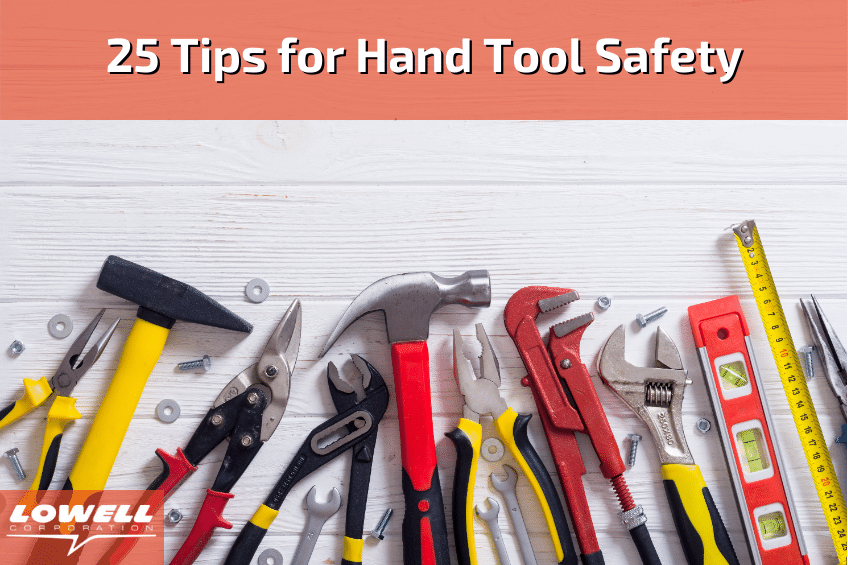Top 5 Utility Worker Safety Tips
Utility work presents countless risks. Heights, electricity, and power tools all pose serious utility worker safety hazards on a daily basis. The Occupational Safety and Health Administration (OSHA) reported 4,674 U.S. worker deaths in 2017. The construction industry was by far the most dangerous, though utility work fell into many of the same pitfalls. Employees specializing in electrical and waterworks maintenance were the most affected.
Between 2003 to 2010, there were over 160 recorded deaths from contact with electrical currents. Aside from electrical hazards, employees who frequently deal with sewage, water, and gas also face substantial environmental risks. Safety hazards in these sectors are exceedingly common, often due to a lack of proper equipment. Simple upgrades like the right lineman wrench can help cut back on these accidents.
Let’s look at a few of the best safety tips for utility workers.
What We’ll Cover:
- Wear PPE
- Monitor the weather
- Use ropes and harnesses
- Prevent electrocution
- Report workplace hazards
- Tips to beat the summer heat
- Lowell’s commitment to safety
1) Wear Personal Protective Equipment
Personal protective equipment (PPE) plays a huge role in workplace safety. Protective equipment like the right gloves and tools can mean the difference between a job well done and a request for medical leave. As a result, we stress the importance of protecting your body. In utility worker safety, a staggering number of accidents happen because of inadequate PPE.
Utility companies should ensure that their staff never wear clothes that could combust, burn quickly, or stick to their skin in a fire. Fire-retardant uniforms like coveralls often decrease the likelihood of deadly burns in the event of an electrical or thermal fire. At a minimum, the outer layer of the uniform should be flame-resistant. Tight or tucked-in clothing helps as well. Any utility workers who work in close proximity to electric arc hazards should wear additional layers of protective clothing or equipment with a sufficient arc rating. OSHA requires full-body protection for any utility worker exposed to over 600 volts.
2) Monitor the Weather
Total-body protection is crucial, but so is accommodating the forecast. Because utility workers do most of their work outside – often in the bright roadside sunlight of highways and street corners – they need to be both safe and comfortable. Always opt for uniforms that are compatible with every season. For example, selecting the best uniforms for summer can prevent heat stroke and fatigue. In utility work, altering uniforms this way could lead to a fall in fatal electric shocks.
3) Use Ropes and Harnesses
Working at heights is an inevitable challenge of utility worker safety. Whether it’s scaling towers, climbing scaffolding, inspecting water and gas systems, or operating machinery off the ground, it’s a clear and present danger. According to the United States Department of Labor, falls associated with working at heights were recorded to be the most significant cause of workplace deaths in 2017.
Heights are the major cause of death in the utility sector. OSHA requires employers to provide updated fall protection systems to curb the rise of fatal falls. Furthermore, every surface in the field should be free from slipping or tripping. Personal fall arrest systems that include ropes, harnesses, and boots are your best highline tools to accomplish this. These systems can save a worker in the event of a fall or a loss of consciousness.
Looking for high-quality highline tools? Read our product guide for utility workers.
4) Prevent Electrocution
Electric shocks and electrocution are extremely common threats to utility worker safety. An employer should try to prevent these accidents by enacting proper electricity safety measures where possible. For instance, utility workers should always be aware of overhead wires when operating heavy machinery. OSHA’s related safety standards are the industry standard for dealing with electric equipment at a job site. Failure to assemble the right lineman tools, uniforms, or guidelines for utility workers could lead to serious electrical accidents and even death.
In utility worker safety, proper equipment prevents employees from making accidental contact with energized parts or equipment. In addition, they prevent accidental contact with energized conductors with a grounded surface. The risk of worker injury skyrockets when a cover-up is not used. A large number of accidents also occur when there is a lack of cover-up, and workers have to move their cover during a job. To prevent this, employers should plan and make sure employees have sufficient cover-up equipment before a job begins.
5) Report Workplace Hazards
Many employee injuries and deaths, tragically, occur due to employer negligence. Contributing to an unsafe workplace could unreasonably place utility workers in jeopardy. Every employer must obey OSHA’s policies and regulations, from properly training utility workers to containing hazardous substances. Never negligently or intentionally break these rules to save time or money.
If a utility worker notices a workplace hazard or violates OSHA standards, they should notify the employer immediately. After that, the utility company must resolve the situation in a reasonable time frame. However, should the company ignore the concern, a utility worker can take the matter directly to OSHA by filing an official complaint anonymously. In response, OSHA will send one of its inspectors to the workplace to investigate further. Common safety violations in the utility industry include a lack of fall protection, lax hazard communication standards, unsafe ladders, and a lack of eyewear or facewear. In any case, OSHA can force an employer to improve the safety of the workplace if there is cause for alarm.
Linemen need tough wrenches that can withstand the test of time. Trust Lowell to make your repairs easier.
5 Tips for Linemen to Beat the Summer Heat
Working under the relentless summer sun can be grueling for linemen, but with the right strategies, they can stay safe and maintain high levels of productivity. As temperatures soar, understanding how to combat heat effectively is essential for preventing heat-related illnesses and ensuring the well-being of every crew member.
1) Stay Hydrated
One of the simplest yet most effective ways to beat the heat is to stay hydrated. Linemen should carry and consume water regularly throughout the day, even if they do not feel thirsty. Hydration packs can be a practical solution in highline work, allowing easy access to water without interrupting the workflow.
2) Wear Appropriate Clothing
Choosing the right apparel can significantly influence comfort and heat management. Lightweight, breathable, and moisture-wicking fabrics are ideal as they help regulate body temperature and keep sweat at bay. Additionally, wearing light-colored clothing reflects the sun’s rays rather than absorbing them, which helps keep body temperatures lower.
3) Schedule Frequent Breaks
It’s important to take regular breaks in shaded or air-conditioned areas. Short, frequent rest periods help the body recover from the heat and prevent heat exhaustion. Employers should consider adjusting lineman training and work schedules to avoid the hottest parts of the day, typically from late morning to mid-afternoon.
4) Use Cooling Products
Products like cooling vests, neck wraps, and bandanas that can be soaked in water are excellent for keeping cool. These products help lower body temperature and are especially useful during peak heat times or in direct sunlight.
5) Stay Informed and Prepared
Monitoring weather forecasts helps anticipate the hottest days and prepare accordingly. Awareness programs on recognizing the signs of heat-related illnesses should be mandatory, ensuring that all linemen can look out for one another. Quick responses to symptoms such as dizziness, headaches, and fatigue can prevent serious health issues.
Ready to save time and money on
your lineman tools?
150 Years of Staying Committed to Safety Standards
By incorporating these tips into daily routines, linemen can safely navigate the challenges of working in high temperatures. Lowell Corporation remains committed to supporting the safety of utility workers with tools designed to enhance both efficiency and safety, ensuring that even in the heat of summer, the focus remains on getting the job done safely and effectively. Whether your job needs a lineman speed wrench, lineman socket, roller clutch, crank handle, or a tight-fit wrench, Lowell has custom solutions for your utility equipment.
For most manual labor and machine design, you need to strike a balance between cost and efficiency. Our ratchet technology strikes the best balance for productivity in construction, maintenance, and manufacturing operations. Let our ratchet and wrench technology make your labor go smoothly. When you use a Lowell tool, you’re backed by the most trusted American wrench manufacturer in the hand tool industry.
Lowell Corporation is proud to manufacture all of its tools right here in the U.S.A. in the heart of New England. All Lowell wrenches are 100% guaranteed with our two-year manufacturer’s warranty.




